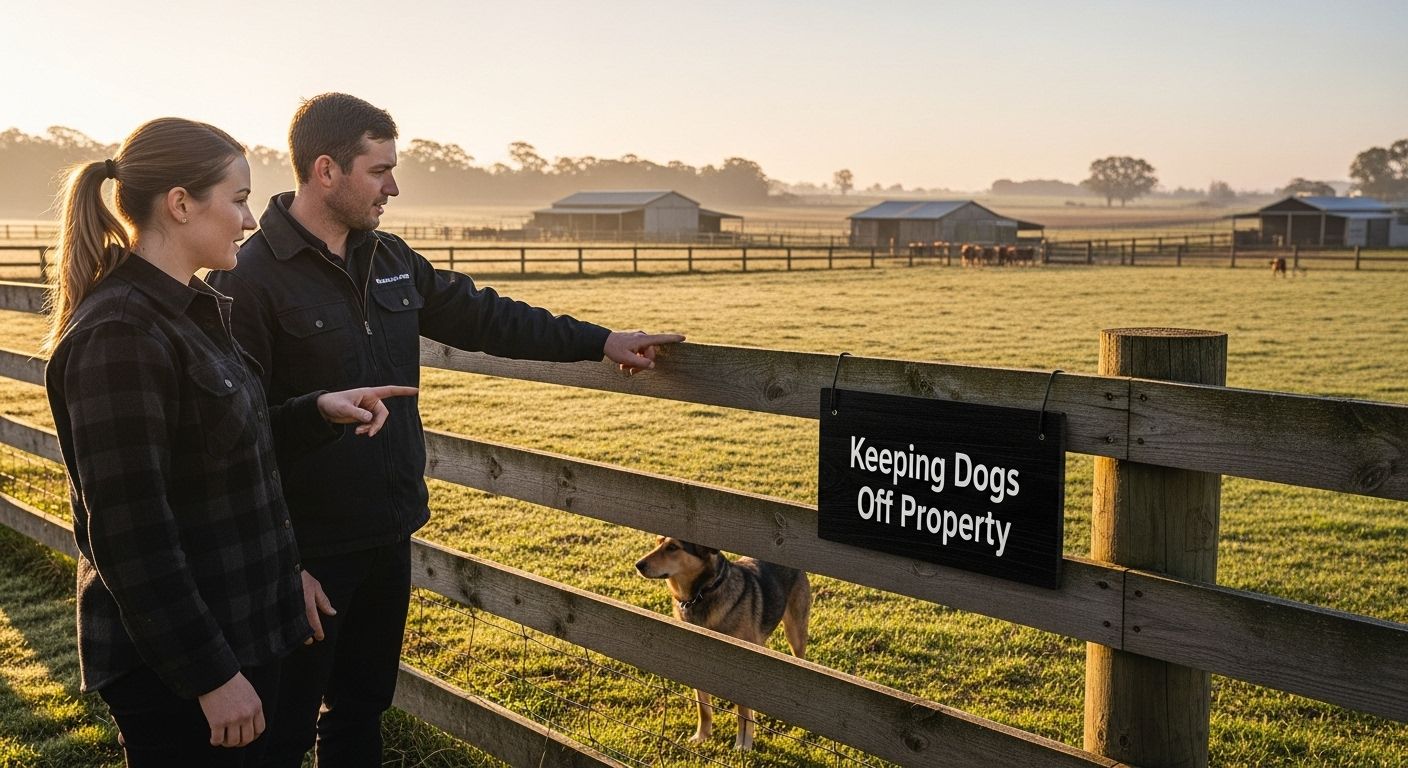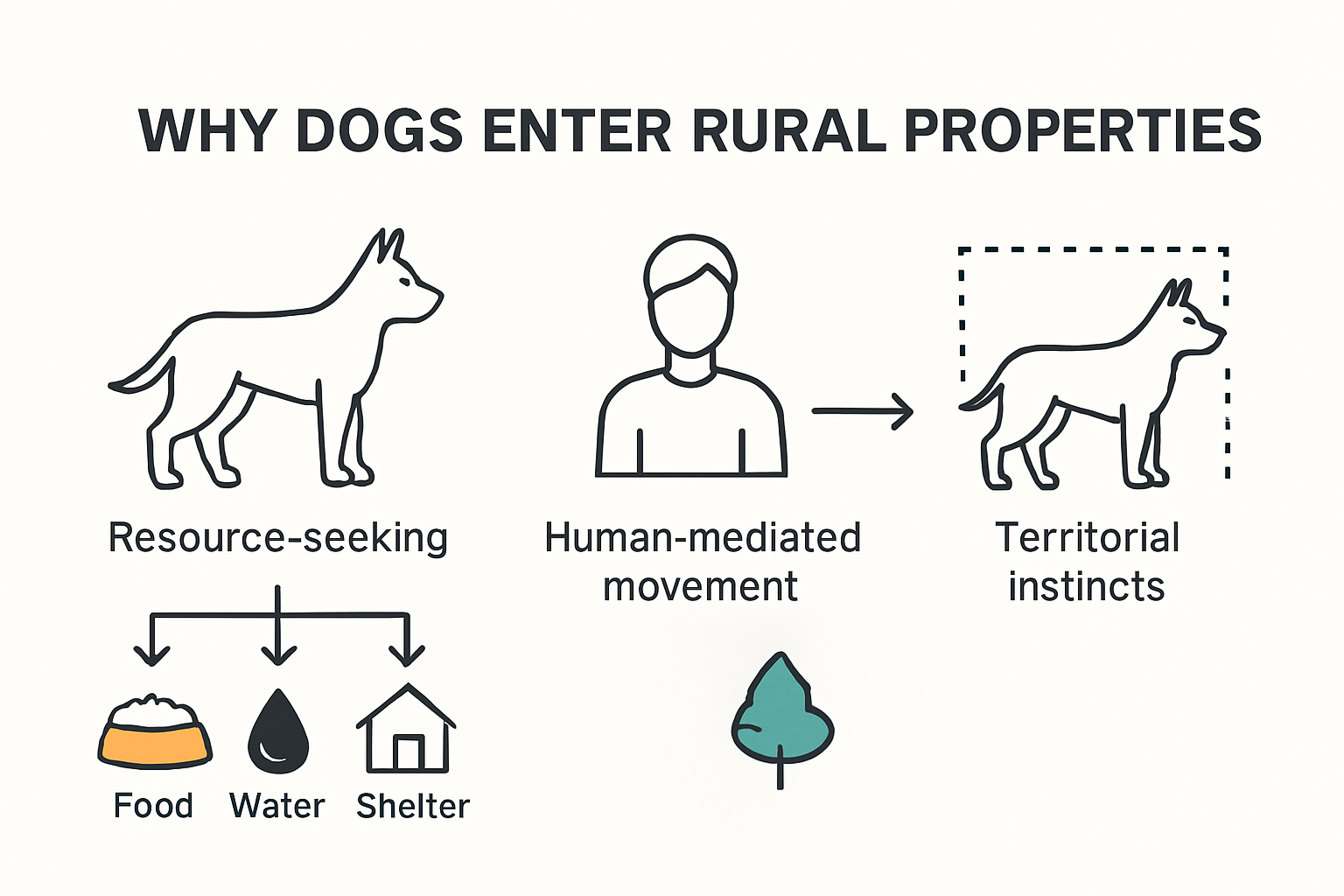
Stray and roaming dogs are a headache for rural property owners for good reason. Dogs make up the majority of all animal trespassing incidents in rural areas, and free-roaming canines are 7 times more likely to enter land with easy access to food or water. Most people think any fence will do the job. But the real secret? Fencing is only part of the solution. The most successful landowners use unexpected strategies that work better than barbed wire alone.
Table of Contents
- Understanding Why Dogs Enter Rural Properties
- Physical Barriers and Fencing Solutions
- Safe Deterrents and Repellents for Dogs
- Legal Considerations and Community Cooperation
Quick Summary
| Takeaway | Explanation |
|---|---|
| Understand dog motivations for entering properties | Dogs seek food, water, and shelter, often influenced by human actions. Recognizing this helps in creating effective prevention strategies. |
| Implement effective physical barriers | Use traditional or electric fencing tailored to your property to deter dogs from entering. Assess local conditions to choose the right solution. |
| Use humane deterrents and repellents | Natural sensory repellents and technological solutions, like sound or motion-activated devices, can discourage dogs without harming them. |
| Foster community cooperation | Open communication with neighbors can aid in mitigating dog-related issues by creating joint strategies and addressing common concerns. |
| Document incidents for legal clarity | Keep detailed records of dog intrusions and any damage caused to understand your legal rights and obligations regarding animal control. |
Understanding Why Dogs Enter Rural Properties
Rural property owners face unique challenges when it comes to managing unwanted canine visitors. Understanding the underlying motivations for dogs entering these properties is crucial for developing effective prevention strategies.
Resource Seeking Behavior
Dogs are opportunistic animals driven by basic survival instincts. In rural environments, they frequently enter properties searching for essential resources. A comprehensive study published in 2022 revealed that free-roaming domestic dogs strongly prefer anthropogenic environments, particularly areas near buildings and roads. This behavior suggests dogs are primarily attracted to locations offering potential food sources, water, and shelter.
Wild and domestic dogs alike may enter rural properties seeking:
- Food sources: Unsecured garbage, livestock feed, or accessible compost areas
- Water access: Livestock troughs, ponds, or open water sources
- Shelter: Barn structures, equipment sheds, or dense vegetation providing protection
Human-Mediated Movement Patterns
Research conducted in southern Chile highlighted a critical factor in rural dog movement: human intervention. Many dogs entering rural properties are not wild animals but result from deliberate or accidental human actions. This includes dogs abandoned on rural roads, pets relocated from urban areas, or animals that have wandered from nearby settlements.
The study demonstrated that human-mediated movement significantly influences dog population dynamics in rural regions. Dogs may enter properties through:
- Accidental escape from nearby farms
- Deliberate abandonment
- Hunting or working dogs losing track of their handlers
- Pets exploring beyond their typical boundaries
Territorial and Ecological Interactions
A scientific examination of domestic dogs in protected areas revealed that canine presence is closely tied to human settlement proximity. Dogs are naturally curious and territorial creatures. Rural properties often represent attractive territories that offer:
- Potential hunting grounds
- Unexplored terrain
- Opportunities for territorial marking
- Interaction with wildlife or livestock
Understanding these motivational factors is the first step in developing comprehensive strategies for keeping dogs off rural properties. By recognizing the complex drivers behind canine intrusion, landowners can implement targeted and humane approaches to property protection.

Effective prevention requires a multifaceted approach that addresses the root causes of dog entry while respecting both animal welfare and property rights. Recognizing that dogs are not intentionally malicious but responding to innate biological and environmental stimuli allows for more compassionate and successful management techniques.
Physical Barriers and Fencing Solutions
Physical barriers represent the most direct and reliable method for keeping dogs off rural properties. Strategic fencing and barrier implementations can significantly reduce unauthorized canine entry while protecting valuable agricultural resources.
Traditional Fencing Approaches
Traditional fencing remains the primary defense against unwanted dog intrusions. Agricultural Extension Research from Oregon State University indicates that proper fencing design is critical for preventing animal movement. Effective traditional fencing solutions include:
- Woven Wire Fencing: Provides dense coverage with small mesh openings
- Barbed Wire: Creates a physical deterrent with multiple strands
- Smooth Wire: Offers cost-effective perimeter protection
- Wooden Post and Rail: Establishes clear property boundaries
The key consideration with traditional fencing involves selecting materials appropriate to local terrain, animal pressure, and specific property requirements. Wildlife Management Research suggests that fence height and material density directly correlate with preventing animal intrusion.
Electric Fencing Technologies
Modern electric fencing represents an advanced solution for rural property protection. These systems provide a psychological and physical barrier that effectively discourages dogs and other wildlife from entering protected areas. Electric fencing works through:
- Delivering a brief, uncomfortable electrical pulse
- Creating a memorable deterrent experience
- Offering flexible installation options
- Requiring minimal maintenance compared to traditional barriers
Advanced electric fence systems can be powered through solar panels, making them ideal for remote rural locations with limited electrical infrastructure. The psychological impact of electric fencing extends beyond immediate shock, creating a learned avoidance response in animals.
Comprehensive Barrier Strategies
Successful dog prevention requires a holistic approach combining multiple barrier techniques. Property owners should consider:
- Layered defense mechanisms
- Regular fence maintenance
- Strategic placement of physical obstacles
- Complementary deterrent technologies
Complex barrier systems might incorporate physical fencing, electric wire, natural obstacles like dense vegetation, and additional deterrent technologies. The goal is creating a multilayered defense that makes property entry challenging and unappealing for wandering dogs.
To help readers quickly compare various types of fencing and barriers discussed, the following table summarizes key features, benefits, and considerations of each physical barrier option for keeping dogs off rural properties.
| Barrier Type | Key Features | Benefits | Considerations |
|---|---|---|---|
| Woven Wire Fencing | Dense mesh, small openings | High effectiveness, durable | Cost; needs proper installation |
| Barbed Wire | Multiple sharp wire strands | Acts as deterrent, widely available | Can injure animals; maintenance |
| Smooth Wire | Simple wire, less abrasive | Cost-effective, easy to install | Lower deterrence for persistent dogs |
| Wooden Post and Rail | Solid wood structure | Clear boundaries, aesthetic appeal | Higher cost and maintenance |
| Electric Fencing | Electric pulse, solar options available | Strong deterrent, low maintenance | Requires power source, training |
| Dense Vegetation/Obstacles | Bushes, natural barriers | Eco-friendly, can supplement fencing | May require time to grow, less control |
Implementing effective physical barriers requires careful planning, understanding local animal behavior, and selecting appropriate materials. Rural property owners must evaluate their specific environmental conditions, potential animal traffic, and budget constraints when designing comprehensive protection strategies.
While no single solution guarantees absolute prevention, a well-designed physical barrier system significantly reduces the likelihood of unauthorized dog entry. Continuous monitoring, periodic maintenance, and adaptive strategies ensure long-term effectiveness in keeping dogs off rural properties.
Safe Deterrents and Repellents for Dogs
Deterring dogs from rural properties requires a strategic approach that balances effectiveness with humane treatment. Safe deterrent methods can help property owners protect their land without causing harm to animals.
Natural Sensory Repellents
Research from the University of Florida’s Institute of Food and Agricultural Sciences reveals that chemical repellents can effectively discourage animal intrusion through multiple sensory mechanisms. These natural deterrents work by triggering unpleasant sensory experiences that make dogs avoid specific areas.
Effective natural repellents include:
- Capsaicin-based solutions: Derived from hot peppers, creating an unpleasant taste and smell
- Predator urine extracts: Triggering instinctive fear responses
- Citrus-based sprays: Producing strong odors dogs find offensive
- Garlic and herb mixtures: Creating unpalatable environmental conditions
The key to successful repellent use lies in understanding that effectiveness depends on multiple factors, including food availability, application frequency, and environmental conditions. Property owners should rotate different repellent types to prevent animals from developing tolerance.
Sound and Visual Deterrent Technologies
Virginia Tech’s Extension research demonstrates that effective deterrents often engage multiple sensory inputs. Advanced deterrent technologies provide innovative solutions for keeping dogs away from rural properties:
- Motion-activated sound devices
- Ultrasonic animal repellent systems
- Flashing light deterrents
- Automated sprinkler systems
These technologies create unpredictable and uncomfortable environments that discourage dogs from entering protected areas. The randomized nature of these deterrents prevents animals from becoming accustomed to a single defensive strategy.
Below is a quick-reference table summarizing common natural and technological deterrents mentioned in the article, including their methods and important usage notes to guide rural property owners in humane dog management.
| Deterrent Type | Method/Mechanism | Usage Notes |
|---|---|---|
| Capsaicin-based solutions | Causes unpleasant taste/smell | Rotate types to prevent tolerance |
| Predator urine extracts | Triggers instinctive fear in dogs | May need frequent reapplication |
| Citrus-based sprays | Produces strong, offensive odor | Apply near entry points and attractants |
| Garlic/herb mixtures | Creates unpalatable environment | Combine with other approaches for best results |
| Motion-activated sound device | Emits sudden, unpredictable noise | Effective when movement is detected |
| Ultrasonic repellent system | High-frequency sound deters animals | Less effective for some dogs; rotate use |
| Flashing light deterrent | Unpredictable visual disturbance | Use at night near frequent entry points |
| Automated sprinkler system | Sprays water when triggered by movement | Combines surprise and aversion |
Comprehensive Repellent Strategies
University of Minnesota Extension experts emphasize that no single deterrent method provides absolute protection. Successful dog prevention requires a multilayered approach that combines:
- Physical barriers
- Natural repellents
- Technology-based deterrents
- Strategic property management
Property owners should consider rotating deterrent methods to maintain effectiveness. This approach prevents dogs from becoming desensitized to any single prevention technique. Additionally, understanding local dog behavior and specific property characteristics allows for more targeted and humane deterrent strategies.
Implementing safe deterrents requires patience and ongoing adaptation. While no solution guarantees 100% prevention, a thoughtful combination of natural repellents, technological solutions, and strategic property management can significantly reduce unwanted canine intrusions.
Ultimately, the goal is creating an environment that discourages dogs from entering while maintaining ethical treatment of animals. Responsible property owners prioritize humane deterrence methods that protect both their land and the surrounding wildlife ecosystem.
Legal Considerations and Community Cooperation
Managing dog intrusions on rural properties involves navigating complex legal landscapes and building positive relationships with neighboring property owners. Understanding legal frameworks and fostering community cooperation are essential strategies for effective property protection.
Property Owner Rights and Responsibilities
The Animal Legal & Historical Center provides critical insights into the legal dimensions of animal trespassing. Property owners have specific rights when dealing with unauthorized animal entry, but these rights come with corresponding responsibilities and legal limitations.
Key legal considerations include:
- Documented property boundaries
- Proving intentional or repeated trespassing
- Demonstrating potential property damage
- Understanding local animal control regulations
Legal protections typically require property owners to demonstrate that dog intrusions cause measurable harm. Documentation becomes crucial, including photographic evidence, witness statements, and detailed records of property damage. Owners must balance protective measures with humane treatment, avoiding actions that could be construed as animal cruelty.
Effective Community Communication Strategies
Successful dog management extends beyond individual property boundaries. Establishing open communication channels with neighbors creates a collaborative approach to preventing canine trespassing. Effective communication involves:
- Hosting neighborhood meetings
- Developing shared understanding of local animal control
- Creating mutual support networks
- Establishing clear expectations about pet management
Proactive dialogue helps identify root causes of dog wandering, such as inadequate fencing, lack of supervision, or specific environmental attractants. By working together, community members can develop comprehensive strategies that address systemic issues rather than treating symptoms.
Conflict Resolution and Mediation
When dog-related conflicts arise, property owners should prioritize diplomatic resolution. Professional mediation services can help navigate disputes, providing neutral ground for discussing concerns and finding mutually acceptable solutions. Key mediation strategies include:
- Remaining calm and factual
- Focusing on specific behavioral issues
- Avoiding personal accusations
- Proposing practical, collaborative solutions
Local agricultural extension offices or community mediation centers often provide resources and guidance for resolving property-related conflicts. These services can help property owners understand their rights while maintaining positive neighborhood relationships.
Implementing a proactive, legally informed approach requires patience, documentation, and a commitment to constructive problem-solving. Property owners must balance assertive protection of their land with respect for community dynamics and animal welfare.
Ultimately, successful dog management emerges from a combination of clear legal understanding, strategic property protection, and collaborative community engagement. By approaching the challenge holistically, rural property owners can create safer, more harmonious environments that respect both human and animal needs.

Frequently Asked Questions
What are effective physical barriers to keep dogs off my property?
Effective physical barriers include woven wire fencing, barbed wire, smooth wire, wooden post and rail fences, and electric fencing. Each type has its benefits and considerations, so selecting the right one depends on your property’s specific needs and terrain.
How can I use natural repellents to deter dogs?
Natural repellents like capsaicin-based solutions, predator urine extracts, and citrus-based sprays can be effective in deterring dogs. These substances create unpleasant sensory experiences that make the area less appealing to dogs.
What technologies are available for deterring dogs?
Techniques such as motion-activated sound devices, ultrasonic repellent systems, and automated sprinklers can effectively deter dogs. These devices create unpredictable and uncomfortable environments for unwanted canine visitors.
What legal rights do I have regarding trespassing dogs?
Property owners have rights to protect their land from unauthorized animal entry, which includes documenting property boundaries and potential damage. It’s essential to understand local animal control regulations and document any intrusions for legal clarity.
Make Your Property Dog-Proof With Trusted Solutions From FenceFast.ca
Keeping unwanted dogs off your rural land is more than a nuisance—it puts your livestock, your peace of mind, and your investment at risk. The article showed how standard fences and one-size-fits-all barriers rarely solve the problem. Persistent intrusions, property damage, and the need for reliable and humane prevention often leave landowners looking for answers.
If you want a real solution that takes your unique challenges seriously, now is the time to explore the expert options at FenceFast.ca. Our platform is fully stocked with proven fencing supplies and advanced electric systems. You get access to robust components, livestock-safe accessories, and the latest deterrent technologies, all designed for Canadian farms and rural properties.

Find the right products and expert support to protect your property today. Browse the full range at FenceFast.ca and experience convenient online ordering, dedicated design consulting, and fast shipping nationwide. Don’t wait while another season of dog intrusions puts your operation at risk—visit FenceFast.ca and take control of your boundaries now.
Recommended
-
[
PFN16100-1 – FenceFast Ltd.
-
[
Gallagher Turbo Wire 2.5mm – FenceFast Ltd.
-
[
Gripple Small Cable Cutter – FenceFast Ltd.
-
[
Polyrope/Braid to Energizer Connector – FenceFast Ltd.
](https://fencefast.ca/products/polyrope-braid-to-energizer-connector)
